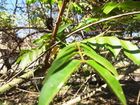Note: This is a project under development. The articles on this wiki are just being initiated and broadly incomplete. You can Help creating new pages.
Difference between revisions of "Caesalpinia crista - Kuberaksha"
(→Photo Gallery) |
(→Photo Gallery) |
||
| Line 66: | Line 66: | ||
<gallery class="left" caption="" widths="140px" heights="140px"> | <gallery class="left" caption="" widths="140px" heights="140px"> | ||
Caesalpinia crista-Bark.JPG|Stem | Caesalpinia crista-Bark.JPG|Stem | ||
| − | + | Caesalpinia crista-Leaves.JPG|Leaves | |
Crested Fever Nut (9320328205).jpg|Flower | Crested Fever Nut (9320328205).jpg|Flower | ||
</gallery> | </gallery> | ||
Revision as of 15:35, 17 May 2019
Caesalpinia crista grows throughout India up to 800 meters elevation. It is a large straggling, very thorny shrub. The branches are armed with hooks and straight, hard, yellow prickles.
Contents
- 1 Uses
- 2 Parts Used
- 3 Chemical Composition
- 4 Common names
- 5 Properties
- 6 Habit
- 7 Identification
- 8 List of Ayurvedic medicine in which the herb is used
- 9 Where to get the saplings
- 10 Mode of Propagation
- 11 How to plant/cultivate
- 12 Commonly seen growing in areas
- 13 Photo Gallery
- 14 References
- 15 External Links
Uses
Wounds, Bladder stones, Kidney stones, Malaria, Colic, Skin rashs, Ulcers, Diarrhea, Hydrocele
Parts Used
Chemical Composition
Bonbucin, Sitosterol, Phytosterol, Heptocosanc[1]
Common names
| Language | Common name |
|---|---|
| Kannada | Kiri-gejjuga |
| Hindi | Latakaranja |
| Malayalam | Kazhanchi |
| Tamil | Mut-konrai |
| Telugu | Mullutige |
| Marathi | NA |
| Gujarathi | NA |
| Punjabi | NA |
| Kashmiri | NA |
| Sanskrit | Kantaki karanja |
| English | Crested Fever Nut |
Properties
Reference: Dravya - Substance, Rasa - Taste, Guna - Qualities, Veerya - Potency, Vipaka - Post-digesion effect, Karma - Pharmacological activity, Prabhava - Therepeutics.
Dravya
Rasa
Tikta ,Kashaya
Guna
Laghu, Ruksha
Veerya
Usna
Vipaka
Katu
Karma
Tridoshahara, varnaropana ,Sothahara
Prabhava
Habit
Identification
Leaf
| Kind | Shape | Feature |
|---|---|---|
| Compound | Compound | Mature Foliage Colour is Green and Mature Foliage Texture is Glossy / Shiny, Leathery |
Flower
| Type | Size | Color and composition | Stamen | More information |
|---|---|---|---|---|
| Bisexual | 2-4cm long | Orange, Yellow / Golden | 5 | Flower Grouping is Cluster / Inflorescence and Flower Location is Axillary |
Fruit
| Type | Size | Mass | Appearance | Seeds | More information |
|---|---|---|---|---|---|
| Simple | Fruit Type is Dehiscent Dry Fruit | Mature Fruit Colour is Brown | seed is black | {{{6}}} |
Other features
List of Ayurvedic medicine in which the herb is used
- Vishatinduka Taila as root juice extract
Where to get the saplings
Mode of Propagation
How to plant/cultivate
Succeeds in any moderately fertile, well-drained soi[3]
Commonly seen growing in areas
River banks, Sandy beaches, Chalk and limestone, Asia - coastal area.
Photo Gallery
References
External Links
- Ayurvedic Herbs known to be helpful to treat Wounds
- Ayurvedic Herbs known to be helpful to treat Bladder stones
- Ayurvedic Herbs known to be helpful to treat Kidney stones
- Ayurvedic Herbs known to be helpful to treat Malaria
- Ayurvedic Herbs known to be helpful to treat Colic
- Ayurvedic Herbs known to be helpful to treat Skin rashs
- Ayurvedic Herbs known to be helpful to treat Ulcers
- Ayurvedic Herbs known to be helpful to treat Diarrhea
- Ayurvedic Herbs known to be helpful to treat Hydrocele
- Herbs with Leaves used in medicine
- Herbs with Fruits used in medicine
- Herbs with Roots used in medicine
- Herbs with common name in Kannada
- Herbs with common name in Hindi
- Herbs with common name in Malayalam
- Herbs with common name in Tamil
- Herbs with common name in Telugu
- Herbs with common name in Sanskrit
- Herbs with common name in English
- Habit - Shrub
- Index of Plants which can be propagated by Seeds
- Herbs that are commonly seen in the region of River banks
- Herbs that are commonly seen in the region of Sandy beaches
- Herbs that are commonly seen in the region of Chalk and limestone
- Herbs that are commonly seen in the region of Asia - coastal area
- Herbs
- Ayurvedic herbs that don't have flower, fruit and leaf photos
- Ayurvedic herbs that don't have seed photos



